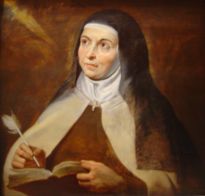St. Hildegard of Bingen
St. Hildegard of Bingen lived in the 12th century. A remarkable woman, she founded a Benedictine convent, served as abbess of her community, studied medicine and physiology, including the use of medicinal herbs, composed and played hauntingly beautiful religious music, wrote poetry and morality plays, produced artistic works, and was a prophetic leader and preacher within the Church of her day.
Hildegard was also a mystic, having had visions beginning around the age of three. When in her early 40s, she began writing of her visions and their meaning. These were presented in three major works: Scivias (Know the Ways of the Lord), Liber Vitae Meritorum (Book of the Rewards of Life), and Liber Divinorum Operum (The Book of Divine Works).
Many of her musical compositions have survived to the present and have been recorded by contemporary artists and orchestras. Her music goes beyond the traditional chant of her day, with a much broader range of notes in her melodies than was common at the time.
Hildegard saw humans as the thinking heart of all creation, called to work with God in shaping our world. Humans, and indeed all of creation, are “living sparks,” “rays of his splendor, just as the rays of the sun proceed from the sun itself.” She taught that our separation from God through sin brought harm to us as humans and to all of creation, but through Christ, we have the way for all to return to our original state of blessing.
In her words:
All living creatures are sparks from the radiation of God’s brilliance, and these sparks emerge from God like the rays of the sun. If God did not give off these sparks, how would the divine flame become fully visible?
Hildegard is honored as a Doctor of the Church. We celebrate her feast on September 17.
St. Hildegard, pray for us as we seek to see God’s face in each other and in all of creation.
Read More













